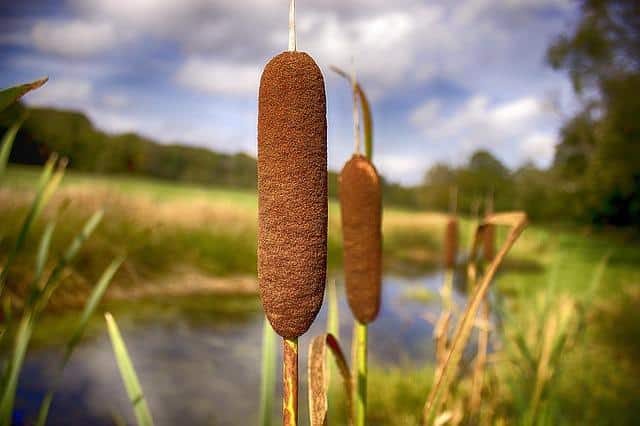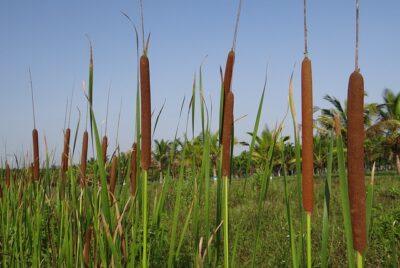A lot has been written about cattails, although the focus often tends to be on warm weather months. But I’ve harvested and eaten this remarkable plant throughout the year.
Still, don’t be tempted to yank out a young cattail shoot and start munching away. The cattail may be safe, but is the water it was growing in safe?
Cattails tend to grow in swampy waters, ponds, lakes, creeks and even ditches. The caution is that many of these bodies of water are rife with aquatic microbes — from amoebas to microscopic parasites — carrying everything from giardia to typhoid. It is one thing to get sick at home and drive over to the doctor or a hospital, but it’s quite another to develop amoebic dysentery in a survival situation. There are simple ways to avoid this but the telegram is: Don’t eat an unwashed section of cattail that has been immersed in any body of water.
And Now The Good News
You can use many parts of the cattail in a survival situation, across all four seasons. There are extremely few plants that can fulfill that level of nutritional, medicinal and functional value from summer through winter. Remote survival environments can often present you with cleaner, safer water, as well.
Let’s examine how it can be used, season by season:
SPRING
As a food source:
From a survival food standpoint, the best parts of a cattail to harvest include the spikes (the emerging plant) in early spring, the spike-shaped shoots throughout spring and early summer, the yellow, pollen-covered heads at the top of the plant mid-spring, and the roots (although the roots are better and bigger as they mature into winter).
Learn How You Can Make Powerful Herbal Medicines, Right in Your Kitchen!
The spikes or emerging plants can be found poking above the water or just beneath the surface. The spikes actually look like a very large leek with a white base extending two to five inches and a long green stalk leading to the early fronds emerging at the top of the plant. I also save the roots at this time, but we’ll get to that later.
I cut the first six to eight inches from the base and collect them. These need to be rinsed in fresh water and ideally, soaked in vinegar for 10 to 20 minutes. Vinegar is a natural antiseptic and will help to kill and remove any bacteria. Rinse them again in cold water or just enjoy them with their vinegar flavor. In an extreme survival situation where you have no resources, you can always roast them over a fire to kill any bacteria.
You might also spot some shoots emerging from the stalks. These show up in spring and continue into early summer. They’re usually above the water line and are triangular in shape. The base is white and you chew the end like a potato chip or strip it with your teeth like an artichoke petal. I’d still give them a rinse if you can, even though they’re above the water.
Some people say the seed heads at the top of the plant can be boiled and eaten like sweet corn. I tried it and didn’t like it. Maybe I should have tried it sooner in the spring, but if I’m starving I’d give it another try.
The roots
Regardless of the time of year, the roots are an excellent source of starch, like potatoes. You need to peel the roots first like a potato, rinse them well and then let them dry. Some sources suggest that you can eat the roots raw. You can eat anything raw, but cattail roots present a very fibrous texture and uncooked can give you stomach and intestinal distress.
Once they’re dry, they’re often pounded into a flour. You can also cut the roots into pieces and crush the root in some water on a board. Drop them in water and the starch will sink to the bottom. You may have to rinse and repeat. That sounds like something you’d find on a shampoo bottle, but you need to do it, followed by carefully allowing the starch slurry to dehydrate. What you’ll end up with is a flour that can be used to bake breads and biscuits or to make pancakes.
Beet Powder: The Ancient Secret To Renewed Energy And Stamina
It sounds like a lot of work, and it is. I prefer to peel and wash the roots and roast them over a fire and then chew them. You can always roast them on the end of a stick. You’ll have to spit out the fibers as you chew.
Functional value
The functional value of cattails in the spring is somewhat limited, only because the immature plants are small in size. That’s because the long fronds of summer and fall that can be used for weaving, cordage and other uses are undeveloped, as is the rest of the plant. However, the dried and dead stalks from the previous season can be used as tinder for starting a fire.
SUMMER
As a food source
In summer, the cattails are beginning to mature but there are still some shoots emerging on the sides of the stalk. The roots are also good, and the same approach applies that we described for spring roots. The seed heads will begin to present pollen in summer, and that can be mixed with the flour from the roots. You can carefully shake the pollen into the flour from the seed head, or cover it with a bag and shake the pollen into the bag.
Functional value
If you take the time to practice a bit, you can learn to weave cattail fronds into just about anything, from baskets, to a hat to protect you from the sun, to cordage, but weaving the fronds into rope is better done in the fall, when the fronds have matured and are tougher and more fibrous.
FALL
As a food source
The roots are now your primary foodstuff and are prepared the same way. They’ll be larger so you can harvest less to get more. The seed heads now have the appearance of a brown corn dog.
Functional value
The cattails have now matured to a tough, fibrous plant. You can still use the fronds for weaving, and now is when the fronds make the strongest cordage.
Willow: Fast, All-Natural Pain Relief With No Nasty Side Effects!
What you’re going to be doing is a basic braiding process of overlapping three or more strands of cattail fronds. You’ll need to add in additional pieces as you go to splice in new fibers. Sometimes you can actually tie small knots to make a better connection from splice to splice. Watch this video to understand this step better:
Story continues below video
You’ll also notice that the seed heads are releasing puffs off fluff. This is an exceptional tinder, and the interior of the seed head will still be dry even in wet weather.
WINTER
As a food source
Roots are at their peak. The seed heads will have gone to seed in pieces of fluff. The stalks and fronds are starting to turn brown. Prepare the roots as before.
Functional value
The seed heads, stalks and fronds have now turned brown. This offers numerous fire-starting and insulation possibilities. The fronds can still be woven, and the seed heads continue to offer excellent tinder in addition to the dry, dead stalks and fronds. Cordage can still be made, but the strength will not be as dependable as fully green and mature fronds.
The seed heads in early winter will be loaded with fluff and can be used as insulation. If you collect enough, you can stuff a T-shirt to make a pillow. The stuff is a real mess if it’s not contained, but in a true survival situation it can be dumped into boots or gloves, adding insulating layers. It’s also highly absorbent if you’re trying to dry out those boots or gloves.
Final thoughts
If you know of a source of cattails, then go out and collect a few and get to know the plant. Depending on the time of year, try some of the suggestions covered in this article. I’ve had a lot of fun sitting on the back porch with my kids and teaching them how to use cattail fronds to weave a basket or make a length of rope. It makes me feel good to know they’re learning some new skills for self-sufficiency and survival thanks to the humble cattail.
Do you know of other survival uses for cattail? Share your suggestions in the section below:
Harness The Power Of Nature’s Most Remarkable Healer: Vinegar
 Off The Grid News Better Ideas For Off The Grid Living
Off The Grid News Better Ideas For Off The Grid Living






